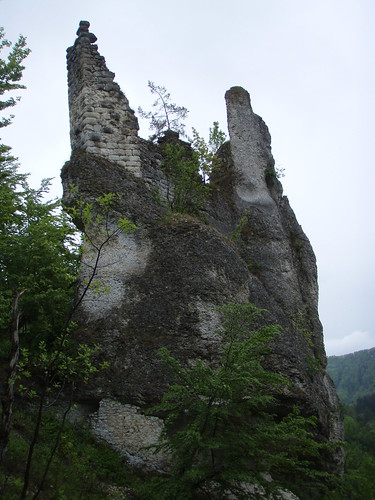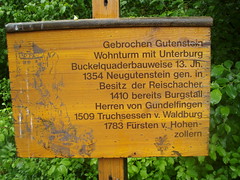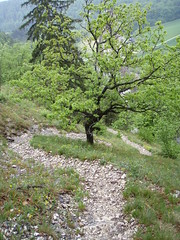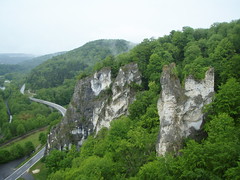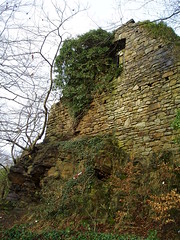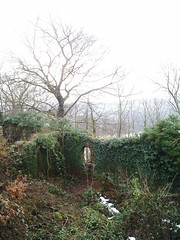Boring Beautiful Caching – my 1500th find
on a 20k hike 'round Germany's "forest city"
My 1500th cache was as boring as the first 1,499: a beaten path leading to a stump, rocks piled neatly between the roots, hmm I wonder where could the cache be?
My 1500th cache had no view, no real challenge, nothing interesting about it all. Except it was part of a fantastic 20km hike through the woods of north western Germany.
We found 31 caches that day on a six-hour tramp around a hill called Froensberg, to the south of Iserlohn, on the western edge of Sauerland. Sauerland (meaning “southern land”) is a hilly densely-forested area along the southern edge of North Rhine Westfalia. Iserlohn (96,000) is the biggest city in Sauerland and is nicknamed the “forest city.”
I first noticed Iserlohn as I was scanning the new maps on geocaching.com and noticed the area is blanketed in caches… a cacher with the nickname “Froensberg” hid two big series in the hills there – one with 8 caches plus a bonus (Rund um Froensberg) and the other with 18 caches plus a bonus (Froensberger Bergtour).
Cache series like these make hiking in unknown territory a breeze. You just go from waypoint to waypoint to waypoint. It’s like having a local guide along to point out the interesting spots and to tell you which path to take.
After studying the maps a bit, I combined the two hikes into one big round trip – with only one short bushwhack. Froensberg mentioned the terrain was quite hilly so I wasnt sure if we would have the stamina to find all 31 or not… so I made notes of points on the hike where we could turn for home.
The really interesting thing about geocaching (and hiking in general) is you never know if things are going to work out exactly as you plan.
Since it was Easter morning, Heike and I compromised on a 9 am departure time. A pleasant and gemütlich breakfast and then we hit the highway. Froensberg, ever the perfect guide, had provided parking coordinates and we just plugged those into the Sat Nav and drove. One hour later we were pulling on our hiking shoes and soaking up the beauty of the rolling hills of Sauerland.
Froensberg’s first cache was one of the best; also a stump only 300m from the car but situated atop a knoll at 475m altitude with a 360° view. Nothing but forests and sunshine all around. We knew then it was going to be a good day.
Our guide then led us down through a stand of tall beeches and oaks to a spot overlooking the village of Froensberg itself (pop. 330). Here we picked up a couple extra caches and left the first series (Rund um Froensberg) after station two. Time to bushwhack to station 18 of the second series (Froensberger Bergtour) and find that series in the reverse order. If everything went to plan, we could just pick up the first series again where we left off.
We plunged into the beech forest and quickly hit on a game trail that led us to beaten path that brought us to a woods road which seemed to be going our way. For a while.
Back into the woods up a steep slope and onto another road and a junction and we started the second series. From station 18 we just followed the series backwards to station 1.
There are zillions of trails and woods roads up in those hills – and sometimes, because we were naviagating backwards, we couldnt be sure which trail Froensberg wanted us to take. But all in all it was child’s play and the trails led us by breath-taking views of more forest and more slopes.
The pollen was falling heavily – everytime the wind blew we could see huge yellow clouds blow up from the hills across the valley. We ourselves were walking in yellow fog the whole day – by times it was hard to breathe and my eyes got scratchy like I had left my contacts in overnight.
The weather was otherwise perfect – sunny and high 20’s with just enough breeze to keep things comfortable. No bugs and no humans all day.
Numbers 1499 and 1500 were especially banale. I imagine Froensberg hid these two more as trail markers. – not as he often did to mark spots with a good view or good places to rest. 1500 was at a trail intersection beside a pond the fire department uses for filling their pumpers.
My log entry:
********* my 1500 th find *********
– !! woohoo yeehaw yabba dabba doo !! –
a great big thank you to the owner, Froensberg, for helping me mark the milestone with a super hiking tour exactly the stuff i love about caching – great views, challenging trails, peaceful clean wilderness
many many thanks!!
herzlichen dank an froensberg dass ich den Milestone mit dieser tollen runde feiern dürfte
(die runde ist echt klasse gemacht )
14.10 pm
a quick and easy find – seems a long way for the fire department to come for water…
15th of 31
There was no view and no spot to relax here so we postponed our celebratory picnic til the next cache, Froensberger Bergtour 8 . There was a big stretch of (pollen-covered) grass there under a couple oaks with a great view down the valley. My log:
14.30 pm
took a long break here to celebrate #1500 – brötchen mit (kaltem) bratwurst, köpi, milka und haribo – a german feast
When we took our socks off here to put on fresh ones, we discovered our feet had turned yellow with pollen. After a quick nap in the shade we set off again determined to find 15 more.
The trail led us up into the hills and down, along a sweet winding footpath, back onto public hiking trails and then, a couple hours later, at 4.20 pm, up up up to “Froensberg Bergtour 1″. This was the last cache for us in this longer series of caches.
We sat down on a stump to figure out the bonus. In the logbook of every cache we had found six smileys of different colours.
There were no clear instructions about what to do, but it seemed maybe we should add the number of smileys for each colour and subtract those numbers from another set of numbers in the bonus description…
Anyway we came up with set of coordinates that seemed entirely possible and just happened to lie on our path back to the first (shorter) series (Rund um Froensberg).
And sure enough, between the roots of a tree under some neatly piled rocks we found the bonus. Considering we had done the tour backwards, it was a big stroke of luck that the bonus would be located so conveniently for us. From here it was only another 200m to pick up the first series where we had left off.
We could have actually easily headed home from here (we were back in the village of Froensberg) but with only seven more caches to go, it would have been a shame to stop.
The last few caches were among the most interesting – there were great views of Islerlohn, there was a burial mound or barrow, and a couple of tree hugger caches – where little beech trees were growing around older firs.
An hour later we found the last cache (between roots under neatly piled rocks) and sat down to figure out this bonus. The coordinates led us to a little field overlooking our parking spot.
On the edge of the field was a hollow stump with a tidy pile of rocks inside….

